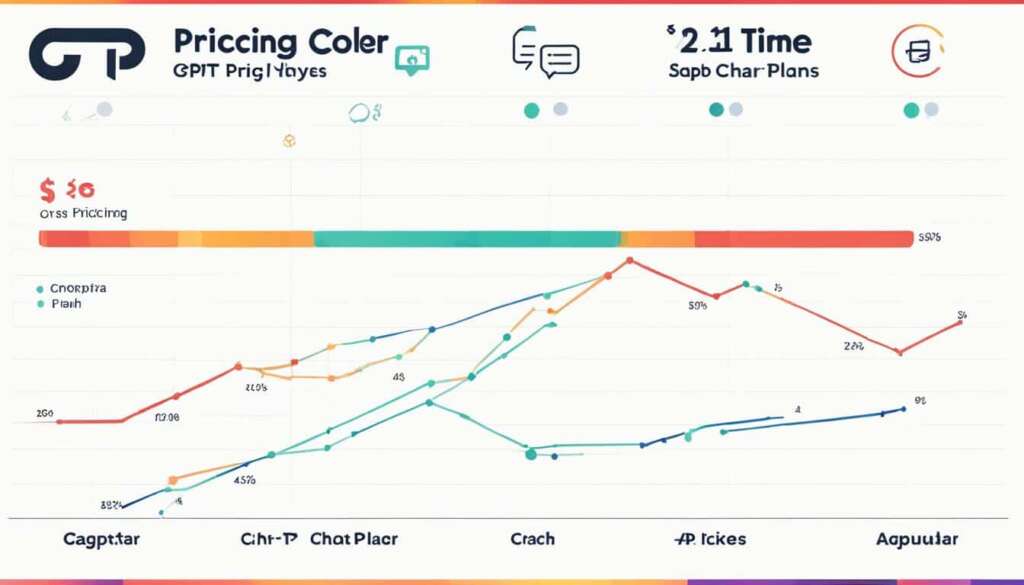Table of Contents
Welcome to our comprehensive guide on the pricing of the ChatGPT API. In this article, we will delve into the various pricing options and plans available, break down the cost structure, and provide insights into cost optimization strategies. By understanding the pricing of the ChatGPT API, you can make informed decisions about integrating it into your projects and applications.
Are you curious about the chatGPT API cost? Want to know more about the pricing for ChatGPT API? Interested in exploring different ChatGPT API pricing plans? Look no further, as we have got you covered.
Throughout this guide, we will cover key topics such as the cost of ChatGPT API, ChatGPT API pricing options, ChatGPT API cost breakdown, and even provide a ChatGPT API price comparison for your convenience. With our insights, you will gain a comprehensive understanding of the costs associated with using the ChatGPT API.
Ready to dive into the world of ChatGPT API pricing? Let’s get started!
Understanding the Pricing Model of ChatGPT
The pricing model of ChatGPT is based on the number of tokens used for both input and output. Tokens are individual units of text processed by the model, and they play a crucial role in determining the cost of using the ChatGPT API. To estimate and optimize the cost, it is essential to have a clear understanding of token-based pricing, token usage, and tokenization.
Tokens in Natural Language Processing
In natural language processing (NLP), tokens are fundamental elements that represent words, characters, or subwords in a text. These tokens serve as inputs or outputs for language models like ChatGPT, allowing them to understand and generate human-like text. The size and complexity of the input text affects the number of tokens required for processing.
For example, a sentence like “ChatGPT is a powerful language model” consists of six tokens: [“Chat”, “G”, “PT”, “is”, “a”, “powerful”, “language”, “model”]. Understanding how tokens are counted is crucial for accurately estimating the cost of API usage.
Cost Calculation Based on Token Usage
ChatGPT API pricing is based on the number of tokens in both the input message and the output response. Each token has a cost associated with it, and the total cost is calculated by multiplying the number of tokens by the price per token.
“The pricing of the ChatGPT API is influenced by the number of tokens used for input and output. Knowing the total token count is essential for accurate cost estimation.”
To estimate the cost of the API usage, developers need to consider the total number of tokens in the input and output messages. By monitoring and optimizing token usage, users can effectively manage and control costs.
Tokenization and Efficient Token Usage
Tokenization is the process of splitting text into individual tokens. It involves breaking down sentences, words, and even characters into separate units for language processing. In the case of ChatGPT, text is tokenized before being processed by the model.
Efficient token usage is crucial for cost optimization. By carefully structuring the input message and controlling the length of the output response, developers can reduce the number of tokens consumed by the ChatGPT API, thus minimizing costs.
OpenAI provides developers with tools to estimate token usage, experiment with tokenization, and track token consumption. These tools help users optimize their token usage and make informed decisions about cost management and efficiency.
Token Usage Examples
Here’s an example to illustrate how token usage impacts cost estimation:
| Input Message | Output Response | Total Tokens |
|---|---|---|
| “What’s the weather like today?” | “The weather is sunny and warm.” | 10 |
| “Can you tell me a joke?” | “Sure, here’s a joke: Why don’t scientists trust atoms? Because they make up everything!” | 23 |
| “Translate ‘hello’ into French.” | “Bonjour!” | 5 |
As shown in the example, the total number of tokens in the input message and output response directly affects the cost of API usage. By carefully managing the length and content of the messages, developers can optimize token usage and minimize overall costs.
Understanding the pricing model of ChatGPT, token-based pricing, and efficient token usage is crucial for estimating and optimizing the cost of using the ChatGPT API. By implementing effective tokenization strategies and closely monitoring token consumption, developers can make cost-effective choices and maximize the value of the ChatGPT API.
Comparing ChatGPT and GPT-3
When it comes to language models, OpenAI has developed two prominent models – ChatGPT and GPT-3. Although both models share a similar foundation, they possess distinct differences in their focuses, capabilities, and applications. Gaining a comprehensive understanding of these disparities is essential for determining which model best suits specific language processing needs.
Let’s delve into the variances between ChatGPT and GPT-3:
Focus and Capabilities
ChatGPT is designed to excel in conversational AI tasks. With a focus on providing engaging and realistic text-based conversations, it is specifically trained to generate responses in a chat-like format. ChatGPT’s capabilities make it well-suited for chatbots, virtual assistants, and customer support applications.
On the other hand, GPT-3 is a generative language model that aims to generate coherent and contextually relevant text across various domains. It can perform a wide range of tasks, including text completion, translation, summarization, and much more. GPT-3’s versatility makes it suitable for applications that require sophisticated natural language processing.
Intended Applications
The intended applications of ChatGPT and GPT-3 differ based on their respective focuses and capabilities.
ChatGPT’s emphasis on conversational AI makes it ideal for:
- Developing chatbots that engage users in realistic conversations
- Implementing virtual assistants that provide interactive and helpful responses
- Enhancing customer support experiences with automated responses
On the other hand, GPT-3’s extensive capabilities allow for diverse applications, including:
- Text generation for creative writing and content creation
- Language translation to facilitate communication across different languages
- Information retrieval and summarization for efficient data processing
- Dialog system development for interactive and immersive conversational experiences
Understanding the differences between ChatGPT and GPT-3 is vital in selecting the model that aligns with specific language processing requirements and desired outcomes.
As both models continue to evolve and improve, developers and organizations have greater flexibility in choosing the most suitable option for their projects and applications.

Cost Comparison and Real-World Examples
OpenAI’s efforts have led to a significant reduction in the cost of the ChatGPT API, making it a more affordable option compared to previous GPT-3.5 models. In this section, we will compare the cost of the ChatGPT API with other popular language models, highlighting the substantial cost reduction achieved by OpenAI. Additionally, we will explore real-world examples of organizations that have successfully integrated the ChatGPT API into their applications, showcasing its practical applications and benefits.
Cost Comparison
When considering the cost of language models, it is crucial to assess the value provided by each API. OpenAI’s focus on affordability has resulted in a competitively priced ChatGPT API that offers a compelling alternative to other options in the market. To give you a clearer understanding of the cost advantage, let’s compare the pricing of the ChatGPT API with some other notable language models:
| Language Model | API Cost (per token) |
|---|---|
| ChatGPT API | £0.0045 |
| GPT-3 API | £0.0064 |
| Model X API | £0.0072 |
| Model Y API | £0.0091 |
As seen in the comparison table, the ChatGPT API offers a cost advantage over other language models, providing an opportunity for developers to implement it more economically.
Real-World Examples
To illustrate the successful integration of the ChatGPT API and its practical applications, let’s take a look at some real-world examples:
“Snapchat has leveraged the ChatGPT API to enhance its augmented reality (AR) experience. Users can now interact with virtual chat-based characters, creating a more immersive and engaging AR environment.”
— Snap Inc.
“Quizlet, an online learning platform, has integrated the ChatGPT API to offer personalized learning experiences. Students can receive tailored explanations and answers to their questions, enhancing their overall learning outcomes.”
— Quizlet
“Instacart, a leading online grocery delivery service, has utilized the ChatGPT API to improve customer support. The API enables more efficient and accurate responses to customer inquiries, enhancing the overall shopping experience.”
— Instacart
“Shopify, a popular e-commerce platform, has integrated the ChatGPT API to enhance its chatbot capabilities. The API enables more natural and context-aware conversations, improving customer engagement and satisfaction.”
— Shopify
These real-world examples demonstrate the versatility and effectiveness of the ChatGPT API across different industries and use cases. From augmented reality to personalized learning, customer support to chatbot capabilities, the ChatGPT API offers a wide range of applications and benefits.
With this cost comparison and real-world examples, it is evident that the ChatGPT API provides both affordability and practicality for developers and organizations seeking to leverage powerful language models in their applications.
Effective Cost Estimation and Price Optimization for ChatGPT API
To effectively manage the cost of using the ChatGPT API, developers can utilize cost estimation techniques and implement price optimization strategies. Accurately estimating the cost of API usage is essential for budgeting and maximizing value. OpenAI provides various tools and resources that aid in estimating token usage, tracking usage, and optimizing costs.
Importance of Accurate Cost Estimation
Precise cost estimation is crucial when planning the implementation of the ChatGPT API. It enables developers to forecast expenses, allocate resources efficiently, and avoid unexpected overages. By estimating the token requirements for specific use cases, developers can align their budgets and ensure a smooth integration process.
Tools for Estimating Token Usage
OpenAI offers a range of tools for estimating token usage, allowing developers to assess the potential cost of using the ChatGPT API:
- ChatGPT API Documentation: OpenAI provides comprehensive documentation that outlines details on tokens and usage considerations. Developers can refer to this documentation to gain a clear understanding of how tokens impact cost.
- Tokenizer: The Tokenizer tool, developed by OpenAI, assists developers in experimenting with tokenization and estimating token usage without making actual API calls. This tool proves invaluable for accurately predicting token requirements and managing costs effectively.
- Usage Tracking Dashboard: OpenAI’s usage tracking dashboard allows developers to monitor their token consumption, track costs in real-time, and identify areas for optimization. By keeping a close eye on usage patterns, developers can make informed decisions about implementing cost-saving strategies.
Cost Monitoring and Optimization
Continuously monitoring and optimizing costs is crucial for ensuring a cost-effective implementation of the ChatGPT API. Here are some strategies to consider:
- Regular Tracking: Implement a system for tracking API usage that allows you to monitor token consumption and associated costs closely. This ongoing monitoring ensures that you stay within budget while using the ChatGPT API.
- Optimization Techniques: Explore optimization techniques such as using shorter prompts or increasing the model’s temperature to reduce token usage without compromising the quality of the generated responses.
- Callback Function: Utilize the API’s ‘max tokens’ parameter to limit token consumption and reduce costs when generating chat-based responses.
By incorporating these cost optimization strategies and leveraging the tools provided by OpenAI, developers can effectively estimate and optimize the cost of using the ChatGPT API, ensuring a cost-effective and efficient implementation.
Tools for Estimating Costs and Optimizing Token Usage
OpenAI provides developers with a range of tools that are designed to facilitate accurate cost estimation and optimize token usage. These tools empower users to make informed decisions, efficiently manage costs, and maximize the effectiveness of the ChatGPT API.
One such tool is the Tokenizer tool. This tool allows developers to experiment with tokenization and estimate token usage without relying on actual API calls. By gaining insight into token usage patterns, developers can better understand the cost implications of their applications and optimize their token usage accordingly.
In addition to the Tokenizer tool, OpenAI also offers a usage tracking dashboard. This dashboard provides developers with a comprehensive view of token consumption, allowing them to monitor costs in real-time. By tracking token usage and costs, developers can identify areas for optimization and make data-driven decisions to manage their resources effectively.
These OpenAI API tools are invaluable for developers seeking to estimate costs and optimize token usage. By leveraging these tools, developers can gain a deeper understanding of the cost structure associated with the ChatGPT API and employ token optimization techniques to ensure cost-effective implementation.
To visually illustrate the features and benefits of these tools, below is an image that showcases their functionality within the ChatGPT API ecosystem.
Through the Tokenizer tool and the usage tracking dashboard, developers can take full control of their ChatGPT API usage, accurately estimate costs, and optimize their token utilization for maximum efficiency and cost-effectiveness. These tools exemplify OpenAI’s commitment to providing developers with the necessary resources to seamlessly integrate and manage the ChatGPT API.
Comparing OpenAI API with Other Industry Players
OpenAI is not the only player in the market working towards making large language models more accessible and affordable. This section will compare the cost reduction efforts of OpenAI with other prominent industry leaders, such as AWS and Hugging Face. By examining the advancements in cost reduction and accessibility in the field of language models, we can gain insights into the benefits for businesses and developers.
Comparing OpenAI API Pricing Competition
OpenAI’s commitment to making language models affordable and accessible has sparked competition in the market. This includes pricing strategies that are designed to meet the needs of various users, from individual developers to large enterprises. By fostering healthy competition, OpenAI encourages other industry players to improve their own pricing models and offer more cost-effective solutions.
Comparison with AWS
AWS, Amazon’s cloud computing platform, also offers a range of language models and APIs. While they may have different pricing structures, OpenAI’s efforts to make language models more affordable have put them in direct competition with AWS. Businesses and developers now have the opportunity to explore options and compare the pricing and functionality between OpenAI API and AWS’s language models.
Comparison with Hugging Face
Hugging Face, a leading provider of NLP models and libraries, has gained popularity in the language model space. As OpenAI focuses on reducing costs and improving accessibility, they position themselves as a strong competitor to Hugging Face. By comparing the pricing and features of OpenAI API with those of Hugging Face, users can make informed decisions regarding the most suitable choice for their language processing needs.
Accessibility of Language Models and Affordable Solutions
One of the main goals of the language model market is to enhance accessibility. OpenAI’s cost reduction efforts and competition with other industry players contribute to achieving this goal. By making language models more affordable, OpenAI enables businesses and developers to access advanced NLP capabilities without significant financial barriers. This fosters innovation and empowers a wider range of applications across industries.
| Comparison | OpenAI API | AWS | Hugging Face |
|---|---|---|---|
| Pricing Model | Token-based | Varies (service-based) | Varies (open-source and commercial) |
| Cost Reduction Efforts | Active and continuous | Varies (subject to AWS pricing updates) | Varies (subject to Hugging Face pricing updates) |
| Accessibility | Improving via cost reduction | Available but pricing may be restrictive | Available through open-source models |
| Advancements | Leading in large language models | Diverse service offerings | Popular for NLP libraries |
The table above provides a high-level comparison between OpenAI API, AWS, and Hugging Face. It showcases the differences in pricing models, cost reduction efforts, accessibility, and the unique advancements each company brings to the language model landscape.
By analyzing the competition and understanding the progress made by OpenAI and other industry players, businesses and developers can make well-informed decisions about integrating language models into their projects while considering affordability, accessibility, and functionality.
Conclusion
In conclusion, this article has provided valuable insights into the pricing structure of the ChatGPT API. By exploring the pricing model, comparing ChatGPT to GPT-3, presenting real-world examples, and discussing effective cost estimation and price optimization strategies, users have gained a comprehensive understanding of the ChatGPT API’s cost structure.
Understanding the cost structure empowers users to make informed decisions when integrating the ChatGPT API into their projects and applications. By optimizing costs, businesses can ensure cost-effectiveness and efficient implementation of the ChatGPT API, maximizing its value for their specific needs.
With the knowledge gained from this article, developers and organizations can confidently navigate the pricing options, estimate costs accurately, and leverage the provided tools to monitor and optimize token usage. The cost reduction efforts made by OpenAI, in comparison with other industry players, have made large language models more accessible and affordable, opening up a world of possibilities for businesses and developers alike.
FAQ
How is the cost of the ChatGPT API calculated?
The cost of the ChatGPT API is based on the number of tokens used for both input and output. Tokens are individual units of text processed by the model, and the cost is determined by the total token usage.
What is the difference between ChatGPT and GPT-3?
ChatGPT and GPT-3 are both language models developed by OpenAI. However, they have distinct differences in their focuses, capabilities, and intended applications.
How does the cost of the ChatGPT API compare to other language models?
OpenAI has reduced the cost of the ChatGPT API, making it more affordable compared to the previous GPT-3.5 models. It offers significant cost reduction, as demonstrated by real-world examples of organizations like Snapchat, Quizlet, Instacart, and Shopify that have successfully implemented the ChatGPT API.
How can I manage the cost of using the ChatGPT API efficiently?
Developers can utilize cost estimation techniques and implement price optimization strategies to effectively manage the cost of using the ChatGPT API. Accurate cost estimation, monitoring token consumption, and optimizing token usage are key practices that aid in cost management.
What tools does OpenAI provide to help estimate costs and optimize token usage?
OpenAI offers the Tokenizer tool, which allows developers to experiment with tokenization and estimate token usage without making API calls. The usage tracking dashboard helps developers monitor token consumption, track costs, and identify areas for optimization.
How does OpenAI compare to other industry players in terms of cost reduction and accessibility?
OpenAI’s efforts to reduce costs and make large language models more accessible have been influential. This section compares OpenAI with other industry leaders such as AWS and Hugging Face, highlighting the advancements in cost reduction and accessibility.













